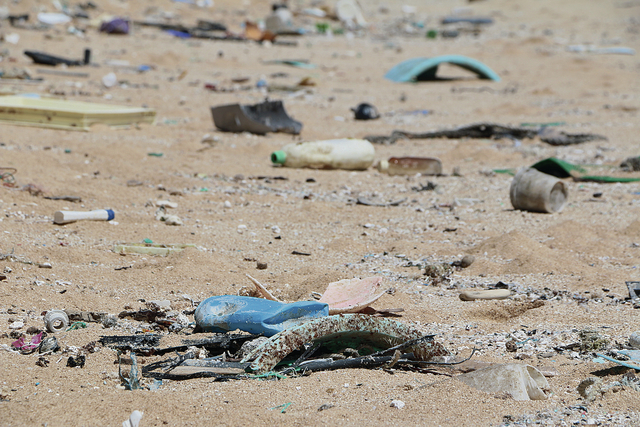More discarded plastic, stray fishing nets and other marine debris is washing up on Niihau than on any of the other eight main Hawaiian Islands, according to a recent, first-of-its-kind study by state officials.
The small, isolated and sparsely populated island off Kauai was found to have the islands’ largest share of marine debris — some 38 percent, a Department of Land and Natural Resources aerial survey between August and November found.
Meanwhile, the state’s most populous island — Oahu — was found to have the smallest debris share, some 5 percent. That’s likely because more stewardship organizations based on Oahu regularly clean the island’s beaches compared with elsewhere in the state, officials with the state land agency said Tuesday.
Each of the other six islands had a share 14 percent or less of the total marine debris found, according to a DLNR release.
DLNR commissioned a local aerial surveying company, Resource Mapping Hawaii, to record high-resolution images using a four-seat Cessna airplane along all of the main islands’ coastlines, state officials said. DLNR officials and the University of Hawaii’s Coral Reef Initiative then spent several months identifying the more than 20,000 “points” of debris revealed in the images, including items as small as 3 inches long, they said Tuesday.
The project relied on $140,000 in funding from the Japanese government given to the U.S. to help study debris from that nation’s 2011 tsunami, officials said. However, DLNR determined that less than 1 percent of the material recorded in the coastal pictures came from the tsunami, according to Kirsten Moy, DLNR’s marine debris coordinator.
Most of the debris was plastic, and most of it came from abroad, she said.
“Because of the way that Hawaii is situated and the currents, it just accumulates on our shores here,” added Brian Neilson, an aquatic invasive species biologist with the DLNR Division of Aquatic Resources, said of marine debris in the state. “So it’s an ongoing problem, and a problem that we’re going to be dealing with for a while since we can’t really control the source of it.”
The study identified “hot spots” where debris washes up — typically on the islands’ north and east shores, Moy said. Niihau, the northernmost of the eight main islands, is likely hit with most debris because of the ocean currents, she added. DLNR wasn’t able to estimate the total weight or volume of the debris, but it could revisit the images and calculate that later, Moy said.
The effort could help other agencies manage marine debris cleanup efforts “on a large scale” — and to hopefully better protect local wildlife and keep the coastline clean for local beachgoers, Neilson said. In the meantime he encouraged local residents to help groups such as Sustainable Coastlines Hawaii and the Sufrider Foundation’s Oahu chapter clean debris off shores.
State officials will use the data as a base line to compare with future debris studies, the DLNR officials said. Follow-up surveys will give them an idea of how quickly the debris accumulates, Neilson said. DLNR is still determining how much time should pass before doing another aerial survey. “Trying to find funding is always difficult,” he added.
CORRECTION
Kirsten Moy served as DLNR’s marine debris coordinator. (Tuesday was her last day in that job.) An earlier version of this story misspelled her name.
|

